Rating of the best laryngoscopes for 2025

Today's review will be devoted to laryngoscopes. What it is? What features does this device have? We will talk about the types and rules for choosing laryngoscopes below.
Content [Hide]
What it is?
Surely, each of us at least once, and maybe more than once, faced such a problem as inflammation of the respiratory tract, in particular, the larynx. All this is accompanied by a sore throat, perspiration and discomfort when swallowing food. Arriving at an appointment with a doctor, he begins to conduct a visual examination - pharyngoscopy.But this method is not always effective. For a more in-depth examination of areas that are inaccessible to the human eye, another instrument is required, namely a laryngoscope. We note the fact that this tool is used not only in the case of diagnosing a patient, but in cases where urgent medical care is required, when anesthesia is required before surgery.
Thus, the tool we are considering is used for:
- Sore throat;
- Identification of the presence of a foreign object;
- Establishing injuries of the integument of the mucosa;
- Establishing the causes of difficulty breathing.
The appearance of all models is identical. Those. in most cases, these are two parts, which are represented by a handle and a blade. Batteries or an accumulator are located in the handle, which contribute to the supply of light. At the top, it ends with a mount. There are special, more advanced models that are capable of conducting research with the translation of the internal state of the respiratory organs on the screen.
The material for manufacturing is different. It can be plastic, then the device will be considered, figuratively speaking, disposable, or it can be steel of various types, here we are talking about reusable use. The latter, after each use, are subjected to a mandatory disinfection procedure.
For storage, a special case is used to protect the instrument from moisture.
Peculiarities
Due to its versatility, the laryngoscope is widely used in medicine. And often, it is included in the list of necessary tools for most therapists and otolaryngologists.
Today, laryngoscopes are manufactured using the latest technologies by leading manufacturers, which allows them to serve for a long time.
It should be noted that the light from the built-in lamp is absolutely safe for the subject, the risk of mucosal burns is excluded.
Below we will consider several representatives of this type of medical instrument.
Rating of the best laryngoscopes for 2025
Flexible Models
These specimens are used for direct laryngoscopy. With such devices, you can examine both the throat itself and the vocal cords. Often, the doctor resorts to this method when they seek help due to the ingress of some foreign body into the throat. Also, direct laryngoscopy is especially effective in the case of examination of oncological neoplasms in the larynx.
Richard Wolf
votes 0

This video is a German-made naso-pharyngo-laryngoscope. Here we will start with the fact that externally the device is very compact, and its design is very ergonomic. In addition, it is easy to use and does not require complex manipulations with the connection to the monitor. It has a special video chip that transmits a high-definition image. Good visibility is provided by a special LED located on the handle. It is used to examine not only the throat, but also the ear and nose.
Due to its high-quality performance and versatility, the price was set at around 674,077 rubles.
- The image is clear and full screen;
- There are auto settings;
- Connection to any kind of monitors, but manufacturers advise the optimal size of 15 ";
- Reduced noise level;
- There is no need for an additional light source.
- High price.
PENTAX FNL-7RP3 – RHINOLARYNGOFIBROSCOPE
votes 0

This model includes a thin optical fiber, designed by the latest system. Sealed packaging reliably protects the device from any kind of damage.What distinguishes this sample from many others is the thin tube, which makes it possible for a specialist to work with children.
The device works from a halogen light source. It has a viewing angle of 75 degrees, and a working length of 30 centimeters, which is typical for these models.
The manufacturer, and here he is Japanese, took into account all the nuances that affect the patient's comfort during the study. In addition to the fact that there are no discomfort when inserting the instrument inside, the risk of injury is also minimized.
This option costs not much cheaper than the previous one, namely, 579 thousand rubles.
- Weight optimal for control with either hand;
- The design of the laryngoscope was created according to the latest, improved technology, when there is the possibility of universal use for both children and adults. Both those and others will not experience discomfort;
- Light is comfortable for perception;
- Easy to manage.
- Not detected.
ATMOS SCOPE
votes 0
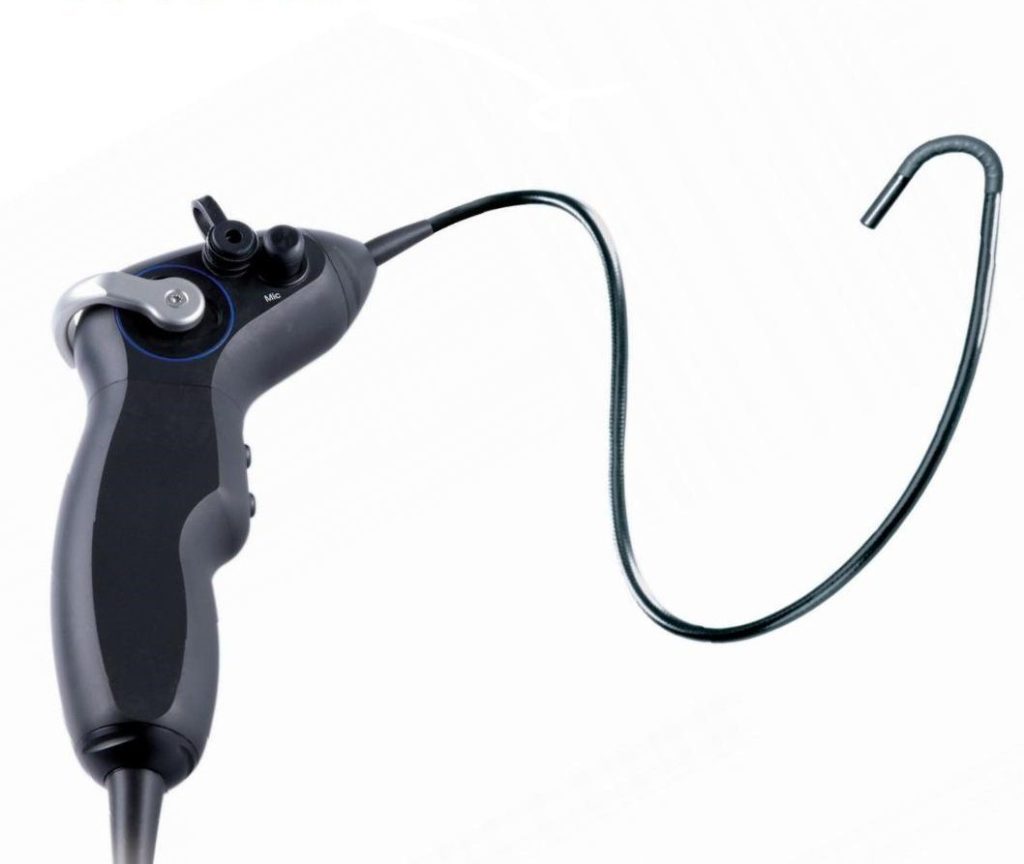
Another representative of German production, which is very popular in its field.
Here is a wide-angle camera that transmits a picture, so to speak, natural, i.e. clear, no distortion. If the previous sample had an angle of view of 75 degrees, then it is already 80, but the length is identical.
As for the installation of this equipment, one of several options can be used, namely:
- At the workplace of the ENT specialist;
- Use as portable equipment for emergency trips;
- Fix in a special examination room by connecting to a monitor.
- There is no need to adjust the settings of the transmitted image, becauseeverything happens automatically;
- User-friendly design;
- Uniform lighting.
- High price.
The price is 750 thousand.
Rigid models
Here we are talking about the indirect method of laryngoscopy. We are talking about the introduction of special mirrors. The specialist sits right in front of the subject, puts a mirror on his head that can reflect light from the laryngoscope. It is it that is able to illuminate the cavity of the larynx well. But, despite the high efficiency, this method is not often used. Consider a few examples of devices related to this classification. It is also worth noting that a tool of this type is much cheaper than the previous type.
Mackintosh with a set of blades (curved) type c
votes 0
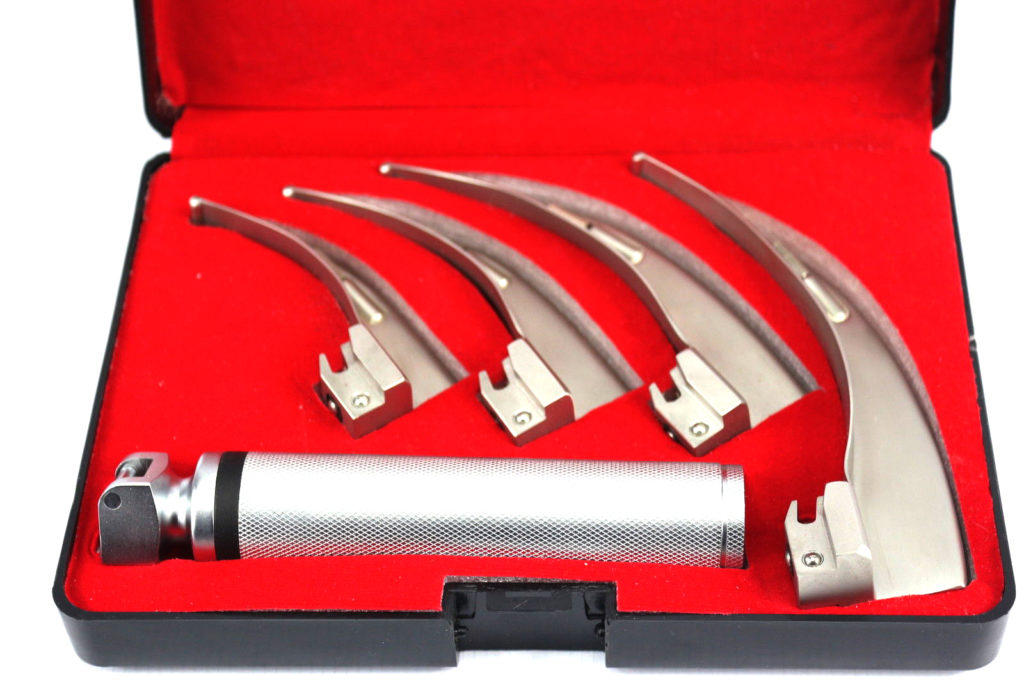
The manufacturer of this model is Pakistan. Made from stainless steel and has a matte finish. It is it that helps to prevent the reflection of the light beam, along with this, the device provides an excellent level of illumination. When used, there is no unnecessary magnetization effect, which can make examination difficult.
The material is resistant to any kind of damage when working with other medical instruments.
In addition to the handle, the kit includes 3 blades. All this is securely packed in a case, and the price of all this is a little more than 10 thousand rubles.
- Availability;
- The manufacturer guarantees long-term use;
- Quality material.
- Not detected.
Ri-standard Miller with battery
votes 0
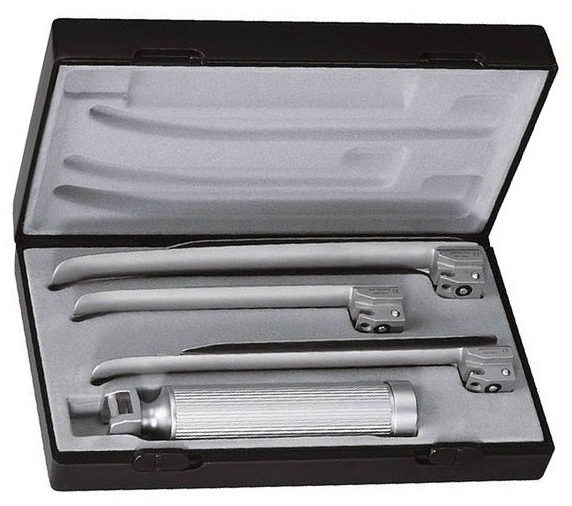
What makes this model different from previous ones? There is a vacuum-type light source capable of well illuminating the examined cavity. The lamp located on the front of the blade is removed without any problems.Robust design allows long-term daily use of the device. Autoclave sterilization is acceptable.
Let's get back to the wedge itself. The material for it was chosen - stainless steel, it is easy to clean due to a specially treated coating.
The whole structure is powered by batteries that are on the handle.
- Sanctification according to the direct principle;
- Removable vacuum lamp;
- Works both from batteries, and from the accumulator;
- Affordable price - 12900 rubles.
- Not detected.
Ri-integral Macintosh No. 8040
votes 0
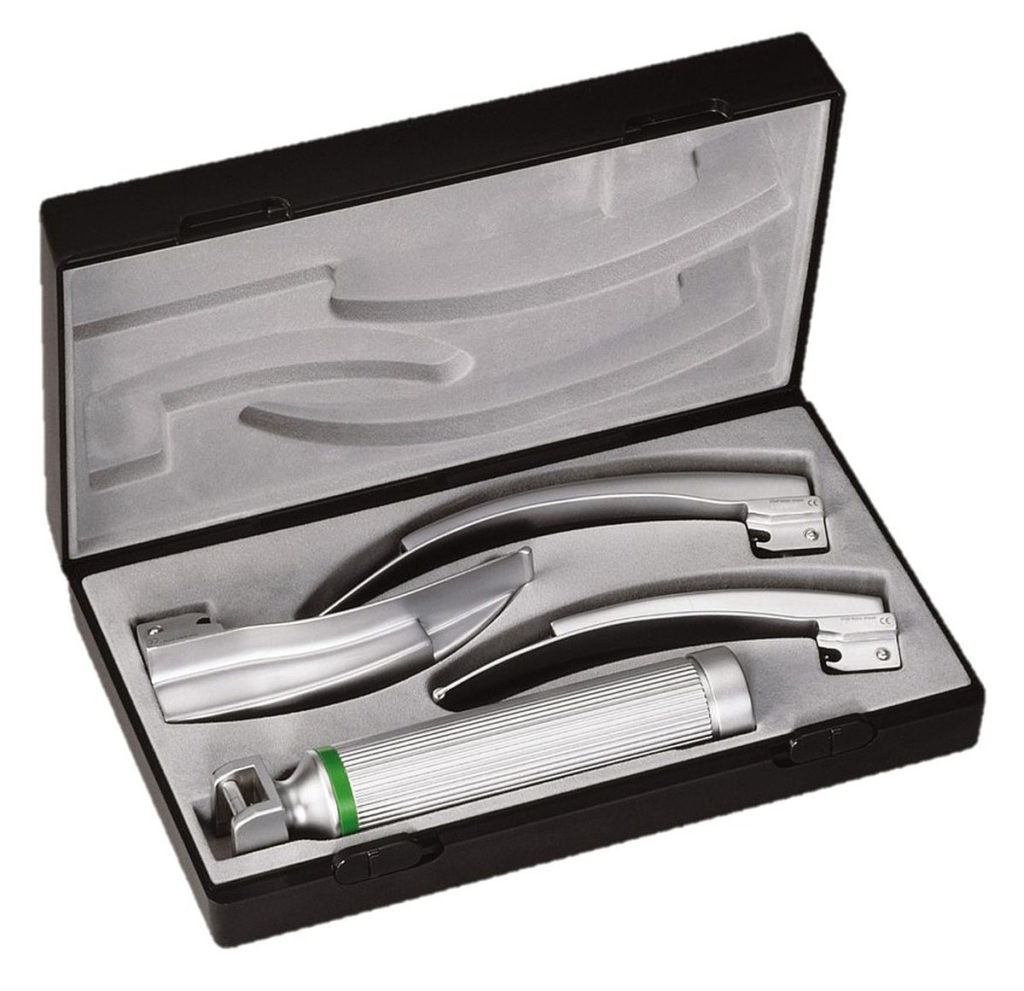
Xenon light is used here, which gives a bright, cold illumination. The lamp itself is located in the handle, metal contacts are also located here. All this is hermetically packed and no damage occurs during sterilization in an autoclave.
The blades are all made of the same stainless steel with a treated surface.
Suitable for examination of the vocal cords, epiglottis. Provides insertion of the intubation tube without discomfort for the subject.
This set is already a little more expensive than its predecessors, namely 43,600 rubles.
- The use of fiber optics;
- Operates on batteries or accumulator;
- The entire set comes in a sealed case.
- Not detected.
Models of different price categories
MacIntosh LUCAS-01 Mega Blade
votes 0
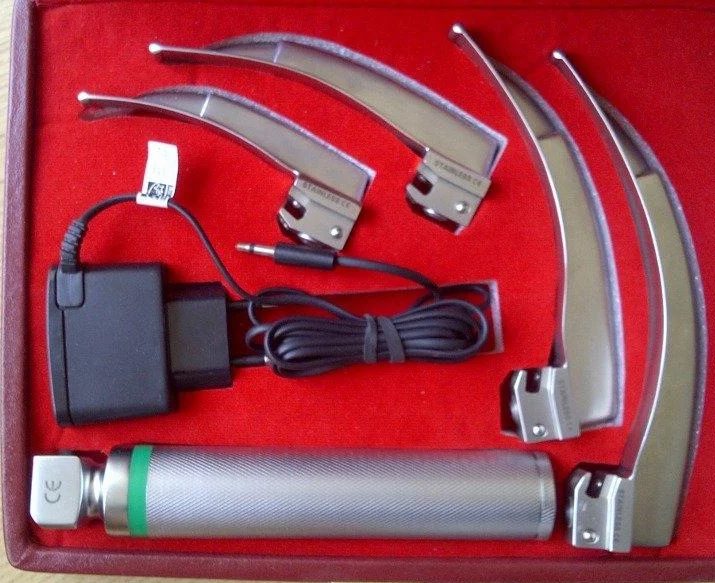
This is a variant of the rigid type of laryngoscopes and it is one of its expensive representatives. The kit will cost a little more than 150 thousand rubles.
Also, it's a Mage Blade type fiber optic tool. The case comes with four blades and a handle with batteries. This product is considered a novelty in the market of its counterparts.The charge is enough for two hours of work, and continuous. The set comes with a charger, which ensures uninterrupted operation without changing batteries.
In this case, we can notice excellent lighting quality, which similar tools cannot provide.
When sterilizing the device, there is no need to disassemble the handle and remove the fiber optic bundle, everything is securely hidden and there will be no damage. Sterilization can occur in any way, but there is still one peculiarity - bleach, oxidizing agent or chlorine should not be allowed to enter the surface. These substances can damage the surface.
The entire set is made entirely of French-made stainless steel.
- Quality material;
- Improved design;
- The set includes four numbered blades.
- Not detected.
HEINE Classic
votes 0
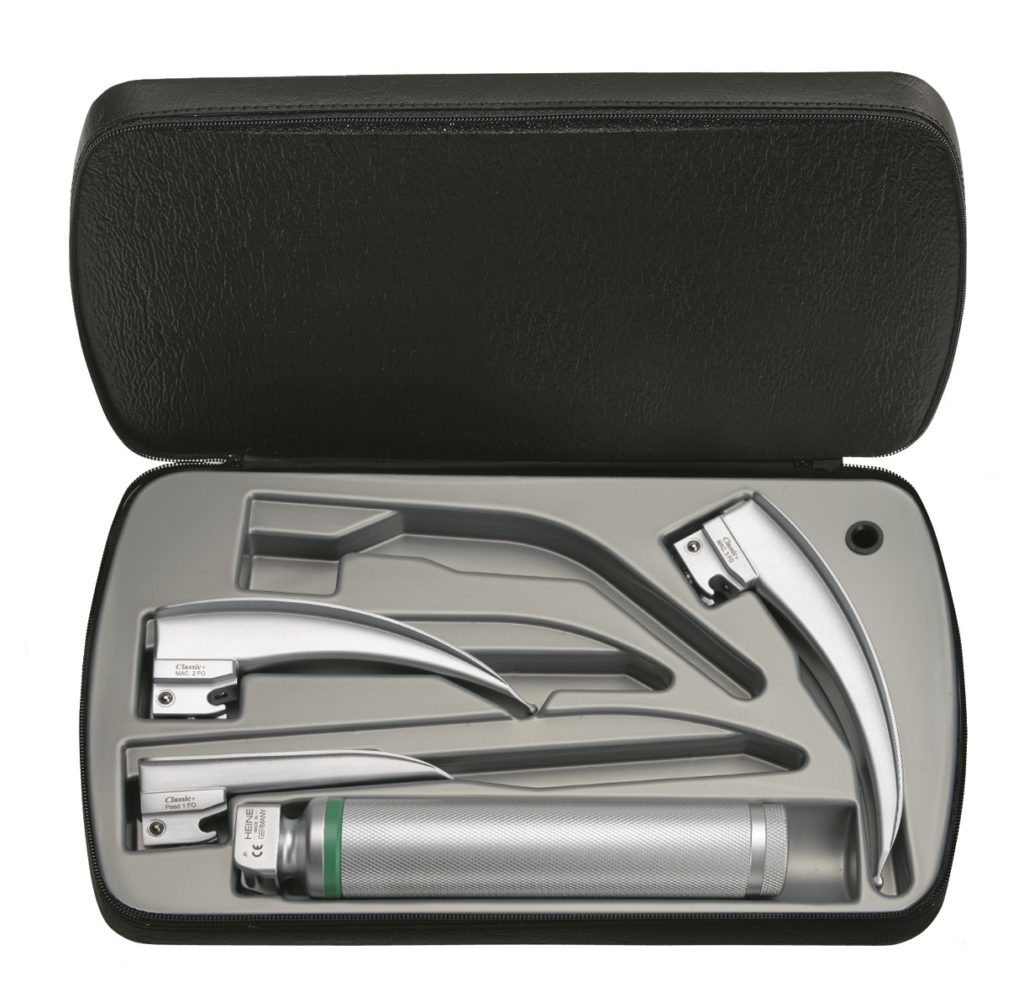
This option is slightly cheaper than the previous one, its price is 77.5 thousand rubles. It is sold as a set, which includes three reusable blades. This model is designed for the examination and examination of children and is applicable even to infants. Due to its smooth surface, the device is easy to clean and disinfect.
By purchasing this set, we get a case in which three blades are neatly packed, a handle that is powered by batteries. When this module expires, there is always the option to replace it with a more powerful one.
- Applicable to children of different ages;
- The absence of fasteners to which the infection can “stick”;
- Ergonomic construction design;
- The product is made of chrome-plated steel.
- Not detected.
Laryngoscope universal model 305
votes 0
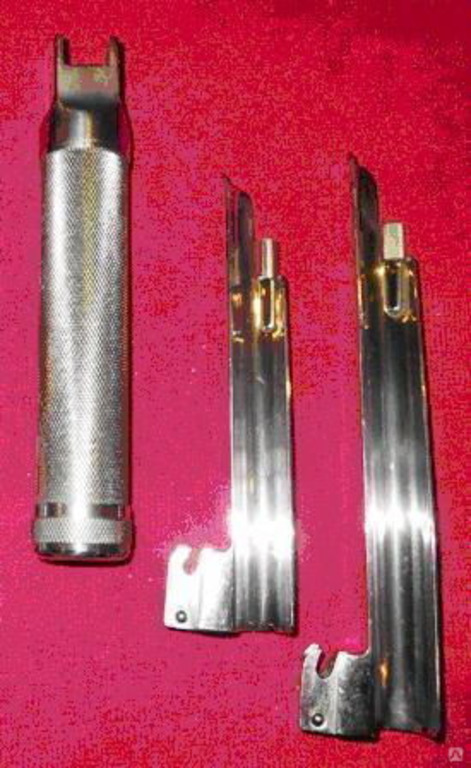
A completely budget option, designed to introduce an endotracheal tube into the trachea to inspect the pharynx.
Represents the classic version when the battery is in the handle. It can be easily detached for replacement. It is easy to use, therefore it is often purchased in some medical or preventive medical institutions.
- Economical - price 3000 rubles;
- Easy to use.
- Not detected.
How to take care of the instrument?
As we have already said, there are disposable and reusable laryngoscopes, and we have already found out how they differ from each other. Now, let's talk about caring for them.
With a disposable instrument, everything is simple, after one use you need to get rid of the device, and in no case should you examine it again.
The situation is different with reusable samples. Because Since the instrument is in direct contact with the mucous membranes of a person, after each contact a very thorough surface treatment is necessary. Two methods are used for processing:
- Chemical;
- Gas.
During processing, it is not recommended to disconnect lamps and LEDs. This can be dangerous due to the fact that the device may fail. All of the above applies to the blade. Remove all batteries and accumulators from the handle.
Almost all manufacturers indicate in the instructions recommendations that must be followed when disinfecting. The desired temperature, the substance that can be used, its concentration, time, and so on, are prescribed there.If we take the chemical method of treatment as an example, then the upper part of the device must be thoroughly cleaned of all substances that may remain on it after the patient. If this is not done, all this may remain on the surface in a dried form. To prevent this from happening, it is enough to rinse the parts in soapy water.
As for the handle, it is enough just to wipe it several times with medical alcohol and carry out the procedure in an autoclave. To do this, you need to set the temperature at 135 degrees and detect ten minutes.
These are basic operating instructions. For each model, the manufacturer provides individual methods of use. They should not be neglected, otherwise the device will simply expire ahead of time.
Conclusion
The device we are considering is an integral part of the activity of an otolaryngologist. Based on what he uses during the examination, the quality of the study and the further recovery process will depend.
Each medical institution has its own types of laryngoscopes. If we are talking about a large clinical center, then, of course, expensive equipment is purchased that is connected to a monitor and the examination is carried out more thoroughly.
If these are small preventive complexes, where there is a separate ENT room for prof. inspections, then the option that we considered last will be enough.
Do not forget that no matter how expensive and high-quality the device is, its durability or, conversely, short-term existence will directly depend on its care and proper use by a specialist.
We hope our review was helpful.
new entries
Categories
Useful
Popular Articles
-

Top ranking of the best and cheapest scooters up to 50cc in 2025
Views: 131662 -

Rating of the best soundproofing materials for an apartment in 2025
Views: 127701 -

Rating of cheap analogues of expensive medicines for flu and colds for 2025
Views: 124527 -

The best men's sneakers in 2025
Views: 124045 -

The Best Complex Vitamins in 2025
Views: 121948 -

Top ranking of the best smartwatches 2025 - price-quality ratio
Views: 114986 -

The best paint for gray hair - top rating 2025
Views: 113403 -

Ranking of the best wood paints for interior work in 2025
Views: 110330 -

Rating of the best spinning reels in 2025
Views: 105336 -

Ranking of the best sex dolls for men for 2025
Views: 104376 -

Ranking of the best action cameras from China in 2025
Views: 102225 -

The most effective calcium preparations for adults and children in 2025
Views: 102019









